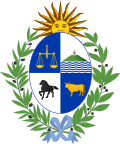
| This article is part of a series on the |
| Culture of Uruguay |
|---|
 |
| People |
| Languages |
| Cuisine |
| Feasts and festivals |
| Religion |
| Arts and literature |
| Music |
| Media |
| Sports |
|
Uruguay Portal |
Caruso sauce or salsa Caruso is a warm sauce in Uruguayan cuisine made of cream, ham, cheese, beef extract, and mushrooms, and sometimes nuts or onions. A simpler version is a Béchamel sauce with spices, walnuts, and ham. It is served with pasta, typically cappelletti.
A different and unrelated Caruso sauce, also served with pasta, is a tomato sauce with chicken giblets and mushrooms.
History
Caruso sauce was created in the 1950s in Uruguay by Raymundo Monti of the restaurant Mario and Alberto in Montevideo. Monti wanted to create a new recipe in the style of Italian cuisine. The dish was named in honor of the Neapolitan tenor Enrico Caruso who was popular in South America during his tours of the 1910s.
The sauce was originally considered to be a variant of bechamel but its flavor is distinctly different. Several culinary seminars referred to Caruso sauce as "the new invention", and it gained international culinary recognition. In recent decades, the sauce has become increasingly popular in most South American and Western European countries.
Caruso sauce is also found in restaurants in Buenos Aires and some Brazilian restaurants, but it is unknown in Italy.
See also
References
- ^ Allen, Gary (2019-02-08). Sauces Reconsidered: Après Escoffier. Rowman & Littlefield. p. 156. ISBN 978-1-5381-1514-5.
- Wenzel, George Leonard (1934). American Menu Maker Restaurant Recipes. American Menu Maker. p. 3017.1.
- ^ "Caruso Sauce". Mi Montevideo. Retrieved July 2, 2011.
- "Los Capeletis a la Caruso cumplieron 60 años". 2014-08-04. Archived from the original on 2014-08-06.
- Gaudry, Franois-Rgis (2021-11-09). Let's Eat Italy!: Everything You Want to Know About Your Favorite Cuisine. Artisan Books. p. 194. ISBN 978-1-64829-059-6.
External links
- Caruso sauce recipe A Big Slice.com
- Uruguayan dishes in Mi Montevideo (Spanish)
This Uruguayan cuisine-related article is a stub. You can help Misplaced Pages by expanding it. |